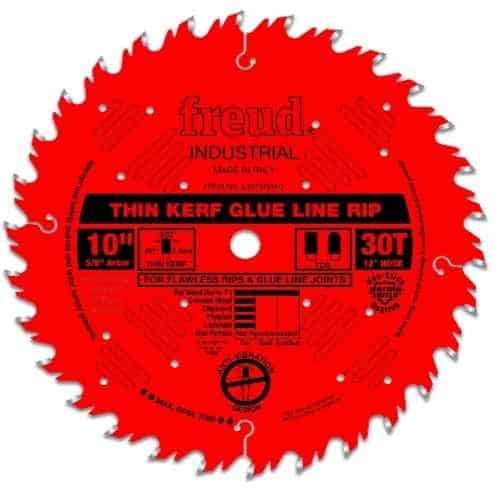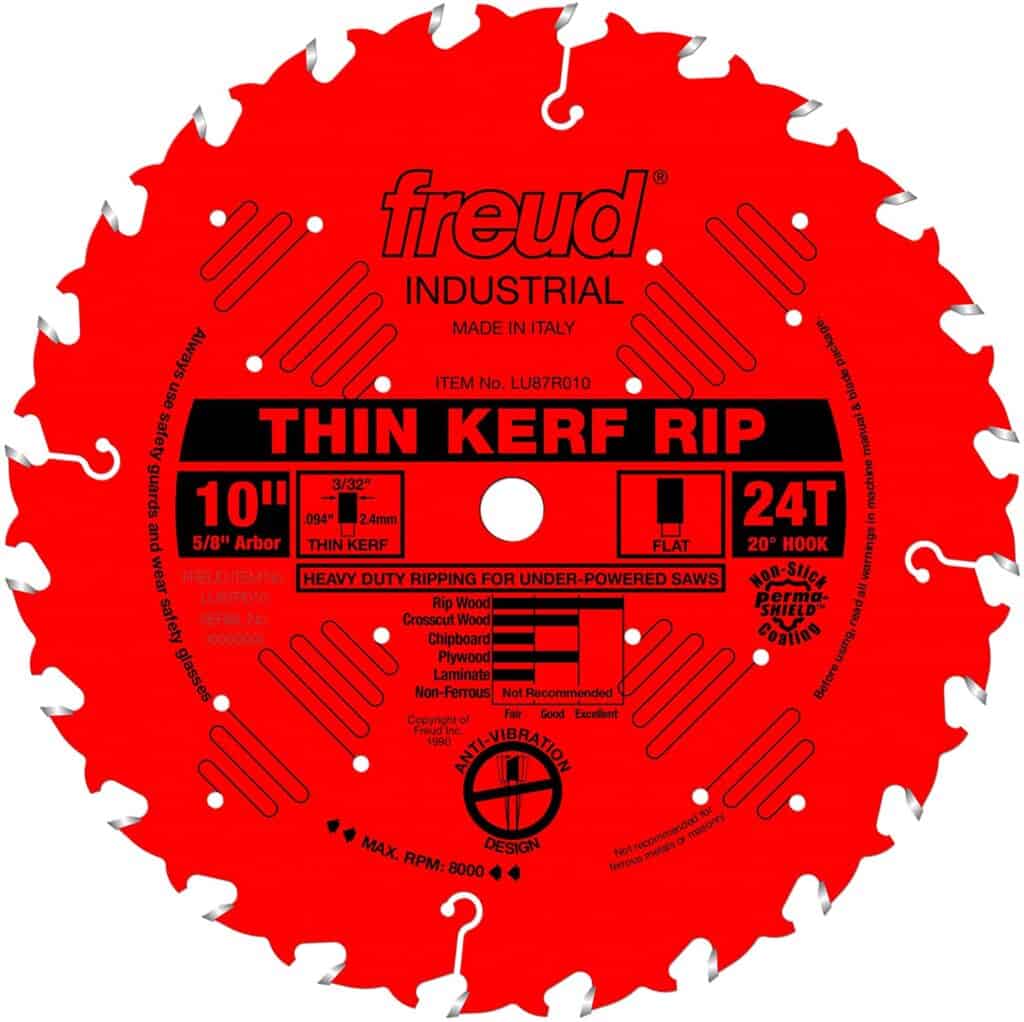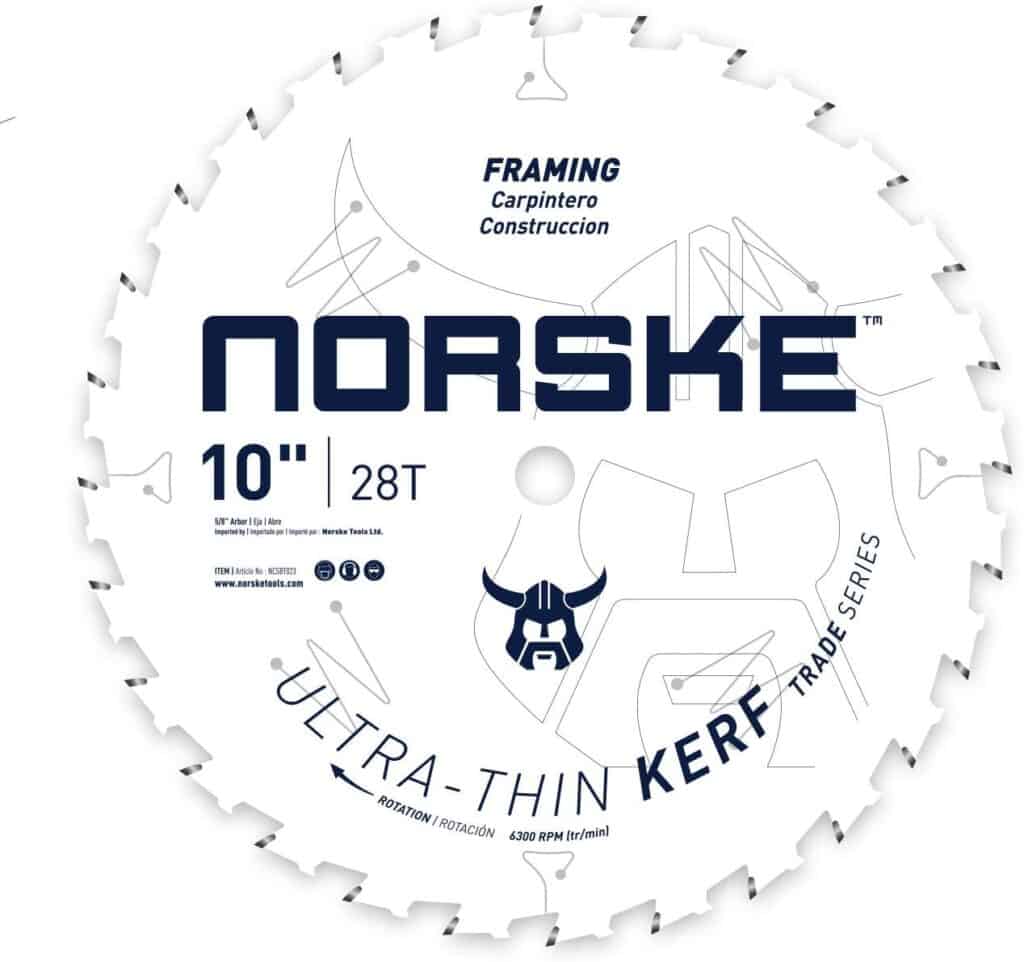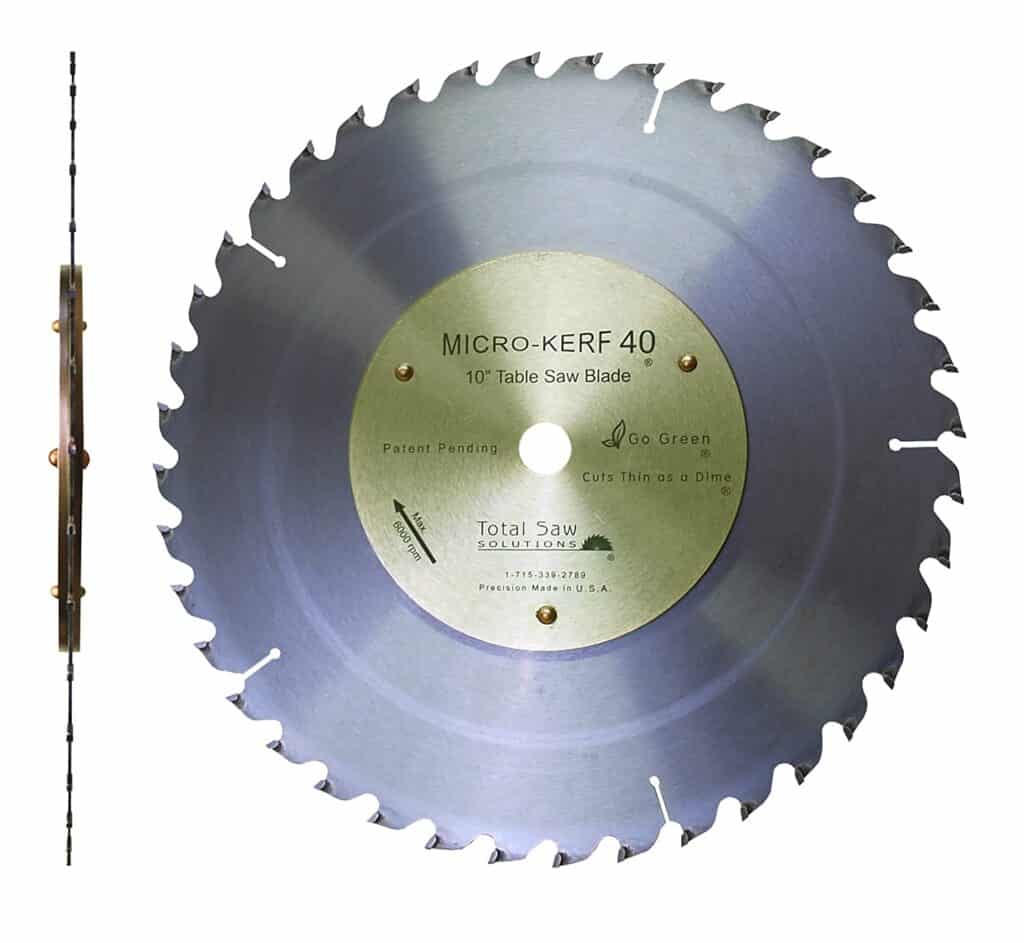












Are you searching for a thin kerf blade for your ripping or crosscutting operations? Then check through this review on the best thin-kerf table saw blade. In this article, we talked about the Freud 10″thin-kerf rip blade, which is our top pick. Also, the Norske 10” Thin kerf Blade, is the blade that gives you the best value for your money. And our premium pick; The Total Saw Solutions 10” Micro-Kerf Table Saw Blade.
Further down the line, we gave an option on a blade suitable for cutting non-ferrous metals and plastics, in case that is what you.
Why not read through this review to assist you in making the right decision.
- Best ripping blade- Freud 10” Thin Kerf Rip Blade
- best for money-Norske 10” Thin kerf Blade
- Premium Choice – Total Saw Solutions 10” Micro-Kerf Table Saw Blade
- Best for cutting metal – Freud 10” Thin Kerf Non-Ferrous Blade
- Best combination blade – Freud 10” Thin Kerf Combination Blade
- Best crosscut blade – Freud 10” Thin Kerf Crosscut Blade
6 Best Thin Kerf Table Saw Blade Review
1. Freud 10” Thin Kerf Rip Blade

Key Features:
- Premium high-density Titanium Cobalt Carbide tips
- High Tech Laser Cuts
- Reduced Kickback Design
- Tri-Metal Brazing
- Laser-Cut Anti-Vibration Slots and Vents
- Premium Permanent Shield Blade Coatings
- Diameter: 10”, Arbor: 5/8”, Hook Angle: 20°, Teeth: 24, Thin Kerf: .094”, Plate: .071”
Ripping your materials is much easy and fast using this dedicated ripping blade. With its big flat tooth design, sharpening is easy, and the following gullets make chip clearance. Materials that can be ripped effectively in descending order are; hard and softwood, plywood, chipboard, and laminate. This blade is not suitable for ripping ferrous and non-ferrous metals. This blade is ideal for low horsepower saws, thanks to the thin kerf of the blade ripping materials ¾ to 2¾ inches thickness without any hassle and little or no waste. Crosscutting is also possible with this blade, though you won’t get smooth cuts.
One huge reason why this blade is our top pick is its high-strength laser-cut steel: stable and flat even while making cuts under heavy loads. This blade is designed in a way that reduces the noise and chattering of the blade. Another fascinating thing about this blade is the teeth tips of high-density carbide, made to rips under any situation while retaining its edge orientation, sharpness, and increased resistance to corrosion, heat, and impact. Unarguably, these two features increase the blade life.
The blade life is further prolonged with a non-stick coating that prevents friction, heat buildup, pitch buildup, and blade warp.
Pros
- There are no burn marks
- It makes little or no waste
- It cuts clean with no deflection
- The blade is very sharp
Con
- Not perfect for crosscutting
2. Norske 10” Thin kerf Blade
Key Features:
- Premium high-density Carbide tips
- Hardened steel alloy body
- High Tech Laser Cuts
- Ultra-thin kerf design
- Diameter: 10”, Arbor: 5/8”, Hook Angle: (10-15)°, Teeth: 28, Thin kerf : .067”, plate: .043”
If you are low on budget, then this ultra-thin kerf is just ideal and valuable for your money at $25. It is very similar to the Freud 10” rip blade as it is a versatile tool for a carpenter to perform ripping operations. The blade works well on plywood, pressure-treated wood, and oriented strand board but not on metals. It also runs at 6300 rpm, consumes less power, and with reduced stock loss. The large flat tooth is sharp and rips effortlessly, and the large gullet clears the chips.
The body of this blade is one of hardened steel alloy body (HRC 40) ripping in a straight and accurate manner. The blade tips are made of micro-grain carbide that retains edges for a lengthy period. The blade also has a heat strain relief feature that keeps the blade true even during a heat. This blade also crosscuts and also has a great kickback design.
Pros
- The laser-cut plate is very quiet.
- The blade is cheap
- It is lightweight and super fast.
3. Total Saw Solutions 10” Micro-Kerf Table Saw Blade
Key Features:
- Premium all-purpose micro-grain Carbide tips
- Blade Splitter
- Stiffening, Noise-dampening collars
- Premium Permanent Shield Blade Coatings
- Diameter: 10”, Arbor: 5/8”, Teeth: 40, Thin Kerf: .061”
Do you care about using a very quiet, thin blade that can crosscut and rip alike? Why not try this all-purpose Total saw solutions 40 teeth micro kerf blade. This blade is perfectly suitable for ripping and crosscutting hardwoods, softwoods, composites, and even plastics. Interestingly, it’s has a whooping speed of 6000rpm max, and it’s also the thinnest and quietest blade in the market, high efficiency, and high cutting strength while producing little sawdust. These and many more make it our premium pick.
This blade fabricated in the U.S.A is often regarded as ‘as thin as a dime blade’. Like other blades in this review, it is an anti-vibration design. Particularly this blade has a built-in stiffener that assists reduce vibration. You can sharpen its carbide teeth up to 15 times.
Further, apart from having a high level of precision, it cuts in-depth to around 2-1/2 inches for table saws and on a miter saw 3-5/8 inches. The blade teeth are triple chip grind. Conclusively, it has a blade splitter insert that prevents kickbacks.
Pros
- It comes with a free instructional material
- Reduces material waste
- It makes smooth and clean cuts
- Very quiet during operation
Con
A bit pricey
4. Freud 10” Thin Kerf Non-Ferrous Blade
Key Features:
- Premium high-density Titanium Cobalt Carbide tips
- Medium Stock Aluminum Blade
- Reduced Kickback Design
- Laser-Cut Anti-Vibration Slots and Vents
- Silver ICE Coatings
- Diameter: 10”, Arbor: 5/8”, Hook Angle: -5°, Teeth: 80, Thin Kerf: .110”, Plate: .087”
First of its kind in our review, a non-ferrous metal cutting saw blade, also suitable for plastics, especially aluminum, copper, and brass. It cuts in the range of 1/16 to ¼ max wall thickness and at a speed of 6000rpm max. Like the Total saw solution saw blade mentioned above, its grind type is a triple chip grind. Thus with this 80 TCG teeth blade, you can make excellent and smooth cuts with a fine finish. At intervals between the teeth of this blade, there are gullets that aid chip clearance.
To extend this blade’s life and further prevent corrosion, pitch buildup, and some form of resistance, the blade is coated with a silver ICE coating. It also has a faster feed rate compared to most standard kerf blades and wastes less material. And like other Freud blades, it has an anti-kickback design to reduce kickback occurrence.
Additionally, this blade has a high-density carbide and high laser cut for optimized performance and resilience under heavy load. It is suitable on a portable table saw, miter saw, and stationary table saw. When using this blade, use a liquid lubricant to minimize overheating of the blade after every 5 cuts.
Pros
- It has a very low vibration
- It does not deform materials
- Almost no edge burrs
- Smooth finish and clean cuts
- Relatively cheap
Con
Not the ideal tool for your woodcuts
5. Freud 10” Thin Kerf Combination Blade
Key Features:
- Premium high-density Titanium Cobalt Carbide tips
- High Tech Laser Cuts
- Reduced Kickback Design
- Tri-Metal Brazing
- Laser-Cut Anti-Vibration Slots and Vents
- Premium Permanent Shield Blade Coatings
- Diameter: 10”, Arbor: 5/8”, Hook Angle: 10°, Teeth: 50, Thin Kerf: .091”, Plate: .071”
This thin kerf combination blade is a fantastic buy for your lumbering operations. It rips thick materials between 3/8 to 1 inch and crosscuts materials between ¾ to 3
inches effectively. With its sharp flat tooth, followed by four ATB teeth in sequence, It cuts along and across materials. Its large gullet clear chips. Whether on a radial arm saw, miter saw, table or portable table saw, it works optimally. Nevertheless, this blade is mainly suitable for working on woods, chipboard, plywood, and laminate, except for ferrous and non-ferrous metals.
As a user, you also enjoy a high-level comfort with its reduced vibration and noise level. Further, this blade is braced with a tri-metal bonding of the carbide tip to the blade steel body. It not only resists impact but also helps in increasing the longevity of the blade alongside other features like the kickback design and a non-sticky shield coating used on the blade’s body.
In terms of performance, this blade makes cleaner cuts than the Freud thin Kerf rip blade, runs at a speed of 7000rpm, is well balanced, consumes less power when compared to a full-kerf saw blade. The blade body and sharp carbide tips are fabricated from high-density steel and a blend of Titanium Carbide, Cobalt, Tungsten, and other elements.
Pros:
- It produces quiet and smooth cuts
- It has an anti-vibration mechanism
- The blade is stable and needs no stabilizer
Con:
- Not a perfect pick for a compound miter saw
6. Freud 10” Thin Kerf Crosscut Blade
Key Features:
- Premium high-density Titanium Cobalt Carbide tips
- High Tech Laser Cuts
- Reduced Kickback Design
- Laser-Cut Anti-Vibration Slots and Vents
- Premium Permanent Shield Blade Coatings
- Diameter: 10”, Arbor: 5/8”, Hook Angle: 15°, Teeth: 60, Thin Kerf: .090”, Plate: .071”
Do you want to make crosscutting of grains with your underpowered saw and with ease? Then this 60 ATB teeth high-density carbide blade is a good option. As a user, you will notice this blade is fabricated with a well-formulated and quality blend of Titanium, tungsten, cobalt, carbide, and some other materials that make the teeth produce sharp cuts and adapt to pressure when under heavy load. The blade also prevents corrosion, heat, and impact
. What of its edge retention? It saves your funds. The teeth also have a positive hook angle that assists a user in making high-precision cuts on molding and other precision woodworks. Though, it’s not suitable for ferrous and non-ferrous metal, like the Freud blade for the metal mentioned above. It is ideal for working on wood or laminate in the range of 1/2 to 2-3/4 inches thick.
The blade is very tough and also protected by a none sticky coat. This coat serves as thermal insulation and further protects the high-density laser cut steel blade from friction, heat buildup, pitch buildup, blade warp, and the working surface and blade body.
The blade is very stable, quiet, and with an anti-vibration feature: it reduces chatter and produces a cleaner finish. All these features also translate to this blade’s long life. Lastly, it will work efficiently with your table saw, portable table saw, radial arm saw, and slide miter saw.
Pros
- It makes clean and highly precise cuts
- Very tough blade, even under heavy load
- It had minimal vibration and functions quietly during operations
Con
- Not suitable for a compound miter saw
Now that we have given the expert verdict on these blades, let’s discuss some details that aid your understanding of the thin kerf blade.
Find the best crosscut sled for the table saw, circular saw, and bandsaw.
Thin Kerf vs Full Kerf: Explained
The kerf of a blade refers to the width of a saw blade carbide teeth. The thickness of a thin-kerf blade is 3/32 inches, and that of a full kerf is 1/8 inches. One notable difference between these two kerf types is that the thin kerf requires less power to run efficiently, and thus, it is best suited for underpowered saws. The full kerf works perfectly with high-powered saws.
Further, a thin kerf blade fits thin-stripped projects, as they consume less wood and in, turn, less sawdust than the full kerf. For saws users who want a high level of precision, low kerf vibration, negligible blade deflection, and do not want the blade to be affected by heat, the full kerf is an appropriate choice.
Let’s also answer some questions.
1. Are thin kerf blades better?
Mainly the project type a saw user wants to embark on, and the horsepower rating of the saw determines the better blade. Thin kerf blades are better for projects that have high material conservation and underpowered saws.
2. What is the thinnest kerf table saw blade?
The Total Saw Solutions’ Micro-Kerf 40 Saw blade happens to be the thinnest kerf table saw blade. Apart from being the thinnest blade in the market, it’s also the quietest carbide teeth blade.
3. How thick is a thin kerf blade?
A thin kerf in respect to a full kerf, thin kerf is 25% thinner. The widthof a thin-kerf blade is 3/32 inches.
4. How do you account for blade kerf?
Kerf is often regarded as the thickness of a blade cut. A user can get this measurement by taking into account the original thickness of a piece of wood before cutting, and then the total thickness of the cut pieces after the cut. The resulting difference between the thickness of the original wood piece and the combined piece cut is the blade kerf. The blade kerf is also visible on the body of most blades.
5. What is the purpose of the kerf on a saw blade?
The purpose of the kerf on a saw blade is to indicate the blade width or the thickness of the blade cut.
We hope you will be able to make positive decisions with the knowledge gained from this review.
Related posts:
Best 8 inch table saw blade reviews
Last Updated on August 5, 2022 by John G. Anderson
Contents






